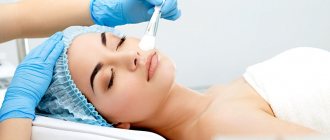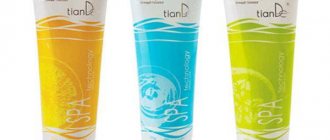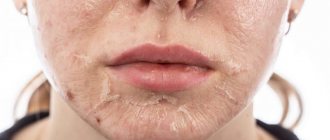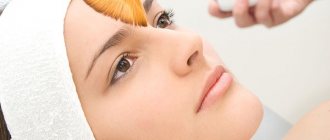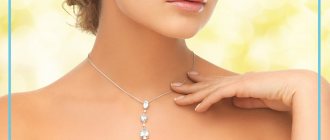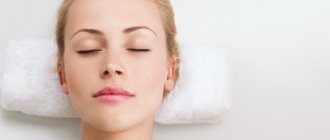Peeling (from English PEEL - peel, peel) is the process of removing several layers of skin with defects to improve the aesthetic qualities of the skin. In cosmetology, chemical peels, ultrasound, laser, and mechanical peeling are used to refresh and rejuvenate the face and body. Chemical peeling is based on the use of acids.
According to the level of impact, they are distinguished: superficial peeling, medium and deep. To achieve a certain result, use the required acid solution with the required concentration. One of these popular chemical peels is the TCA peel. What it is and how the procedure is performed will be discussed in more detail in this article.
TCA peeling - what is it?
TCA peeling is a peeling containing a solution with trichloroacetic acid (TriChloracetic Acid). Chemical TCA peeling is needed to perform superficial and medium peeling. Previously, I did deep TCA peeling, but today I abandoned this procedure. The TCA peeling procedure is a medical procedure and is performed by a cosmetologist.
Peeling should be done in a medical center, not at home. The cosmetologist individually selects the concentration of peeling, recommends pre-peeling preparation and a recovery plan in the post-peeling period.
Contraindications for peeling using TCA technology
Who should not do this type of peeling?
- Pregnant women and breastfeeding mothers.
- People with ARVI, fever, chronic diseases in the acute stage, hypertensive patients.
- For severe rosacea, herpes and acne.
- If there is a recent tan, fresh injuries or lesions on the area of the skin where the treatment occurs.
- If there is a tendency to form scars.
- For acute dermatosis and inflammation.
- If there is a need for radiotherapy.
- Minors and those with mental illness.
This peeling is also not recommended if a person has photodermatitis or the skin is prone to papillomas and warts.
Mechanism of action of chemical TCA peeling
The mechanism of action is the destruction of protein components of the skin (chemical burn of the skin). In the first days, skin redness, swelling, and inflammation are noted. The healing process begins, it averages 7 days. New elastic and collagen fibers are formed, which helps to increase skin elasticity and smooth it. Next, the damaged skin is rejected and exfoliated, replacing it with new areas of cells.
Superficial TCA peeling
Superficial TCA peeling leads to release from the upper layers of the skin to the papillary layer. A 15% or 20% (up to 25%) TCA solution is applied to the skin for up to 15 minutes. The first procedure is carried out with a minimum acid concentration of 15%, the next time the concentration is increased by 5%. The cosmetologist selects the number of procedures and the duration of action of the acid individually, taking into account the person’s gender, age, skin color, its quality and level of damage.
Medium TCA peeling
Medium TCA peeling causes a deeper effect, down to the reticular layer of the skin (its upper level). With it, solutions with a concentration of 25% to 35% TCA are exchanged. To achieve results and reduce the risk of side effects, peelings are combined, using acid with minimal concentrations. The cosmetologist prescribes the number of procedures and duration of peeling individually.
Deep TCA peeling
Deep TCA peeling causes maximum destructive effect on the skin up to the middle layers of the reticular layer. The use of solution concentrations above 35% allows peeling to be applied locally (on a limited area of skin) or in a targeted manner.
Chemical skin peeling: definition, classification
Chemical peeling (chemoexfoliation) is a procedure for applying various chemical agents to the skin to reproduce a chemical burn that is controlled in depth.
Based on the depth of impact, chemical peeling is divided into superficial, medium and deep.
- With superficial peeling, only the horny cells of the epidermis are exfoliated. To perform it, fruit (alpha-hydroxy) acids of varying concentrations are used.
- With medium peeling, damage and subsequent peeling of cells in the middle layers of the epidermis occurs. To perform this, trichloroacetic acid is used.
- Deep peeling involves damage to cells of all layers of the epidermis, right down to the papillae of the papillary dermis. In this case, phenol is used.
How many TCA peels are required?
How many TCA peels are needed? The quantity depends on specific factors, everything is individual. The cosmetologist determines the course for each person. Superficial peeling affects the superficial layers, so it can be applied more often at intervals of 2 weeks to a month. Medium peeling is performed 1 or 2 times a year. Sometimes superficial and medium peeling procedures are alternated. Combinations of peels with reduced concentrations of acid solutions are effective to reduce the risk of adverse reactions (for example, 35% TCA solution + Jessner solution).
The lower the acid concentration, the less destructive effect and the less pronounced effect of use.
Important! When using higher concentrations of acid, the effect is achieved faster, but the risk of burns and scarring increases!
Treatment
You can speed up recovery by using drugs based on natural products and medicines, which should be prescribed by a doctor.
Drugs
The following medications are used to treat burns:
- Panthenol. The active substance is dexpanthenol. Increases the density of collagen fibers, has an anti-inflammatory effect and accelerates the regeneration process. Frequency of application – from 2 to 4 times a day. Pantestin or D-panthenol has a similar effect.
- Elokom. A hormonal drug containing mometasone. Available in the form of lotion or ointment, it eliminates itching, swelling and inflammation. Apply to affected areas no more than 1 time per day.
- Bepanten Plus. The base of the cream consists of chlorhexidine and dexpanthenol. Reduces the risk of infectious complications and scars, has a moisturizing, regenerating and antibacterial effect. You can treat the skin 2 times a day.
- Olazol. Anesthetic spray containing sea buckthorn oil and satin. Helps eliminate swelling and severe flaking. Frequency of use: 1–2 times a day.
In case of severe burns, which are accompanied by the appearance of blisters, the specialist prescribes the following therapeutic regimen:
- treating the skin with regenerating preparations to accelerate the healing process - Panthenol or Bepanten;
- the use of glucocorticosteroids to prevent the spread of inflammation - Diprosalik or Elokom;
- the use of antihistamines to eliminate redness, itching and swelling - Zodak or Claritin;
- taking antibiotics in case of infection spreading - Sumamed or Amoxiclav.
Therapy is prescribed by a doctor only after accurately determining the degree of damage to the epidermis.
Folk recipes
Effective natural remedies for the treatment of burns after peeling:
- Vegetable mask. Grate half a peeled cucumber and a medium potato on a fine grater, add a chopped sprig of parsley. Add 1 tsp to the resulting composition. aloe juice, 1 tsp. freshly squeezed lemon juice and 1 tbsp. l. olive oil. Distribute the mixture evenly over the damaged dermis, leave for 15 minutes, rinse with warm water. Repeat treatment once every 5 days for 3–5 weeks. The mask eliminates itching and swelling, and also has a whitening effect.
- Oatmeal decoction. Make a decoction of 100 gr. oatmeal, add 2 tbsp. l. potato starch. Apply to affected areas, leave for 15–20 minutes, rinse. Do the procedure 3 times a week until the epidermis is completely restored. The product will help get rid of burns and red spots in a short time.
- Avocado mask. Mix 1 tsp. liquid honey and 2 tbsp. l. Avocado puree. Heat the resulting mixture in a steam bath and apply to the affected skin, rinse after 20 minutes.
Before using any folk recipe, you should consult a specialist.
Contraindications for TCA peeling
- Acute period of infectious disease (ARVI, herpes, other viral infections, papillomas and warts).
- Purulent-inflammatory skin diseases (danger of spreading bacterial infection).
- New growths on the skin.
- Dark skin color.
- Allergic skin diseases (atopic dermatitis, neurodermatitis, eczema, etc.).
- Pregnancy, breastfeeding period.
- The use of retinoids (Retin A, Roaccutane) and antibiotics that increase skin sensitivity to UV rays.
- Simultaneous use of traumatic cosmetic procedures (dermabrasion, hair removal, etc.).
Contraindications for TCA peeling are determined by a cosmetologist. The list of contraindications may be expanded, so you need to visit a doctor for a detailed examination and examination.
Indications and contraindications
Tsa peeling is a fairly serious procedure, no longer related to aesthetic cosmetology, but to medical one. There are a wide range of contraindications that will not allow women to try this type of peeling on themselves. Among them:
- any fungal and viral skin diseases;
- bacterial and parasitic diseases;
- tendency to the appearance of keloid scars;
- thyroid diseases and other endocrine problems;
- cold, fever;
- atopic dermatitis, psoriasis, dermatosis, rosacea;
- problems with the cardiovascular system;
- pregnancy and breastfeeding;
- decompensated diabetes mellitus;
- taking retinoids;
- oncology;
- recent chemical peels or facial surgery;
- unhealed cuts, scratches, wounds on the skin;
- allergic reaction to one of the components of the solution.
TSA peeling cannot be done on top of a tan.
Also, tsa peeling should not be done if you have a fresh tan, during menstruation, or with a large number of moles on your face. It is not carried out during periods of solar activity, that is, in summer, spring and early autumn.
As for indications, vinegar peeling is suitable for improving the tone of tired and withered skin, eliminating sagging skin, whitening uneven complexion, smoothing out fine wrinkles, treating oily skin and ridding it of various types of rashes and post-acne.
When and how to do TCA peeling?
Choose the autumn-winter season to start procedures. At this time of year, solar insolation is minimal. The skin after the procedure is very sensitive and when exposed to sunlight, pigmentation may develop excessively.
Preparation before peeling is required. A month before the mid-peel, sunscreens with a high level of protection (SPF 30-50) are used. Before going to bed, tretinoin is prescribed externally and skin bleaching agents are applied.
The mid-peeling procedure is painful. At the discretion of the doctor, painkillers may be recommended for 1 day; a course of prevention of herpes infection is recommended for all patients.
Immediately before peeling, the skin is cleansed and degreased. The face is washed with soap and treated with a sponge moistened with an alcohol solution.
Identify areas of skin that require caution when applying acid. Apply protective Vaseline to the corners of the eyes, lips, surface of the lips, wings of the nose and other areas. When applying spot peeling, markings are performed.
Your face is used to acids
Before the mid-peeling, pre-peel preparation is recommended. This could be one of the options:
- Using home care with acids (the best option is from the same cosmetic line that will perform the peeling);
- Carrying out superficial peeling (or a course of such procedures) several weeks before the main session.
The main purpose of the pre-peel is to reduce the negative reaction of the skin during medium peeling and reduce the risk of irritation. But often during preparation, metabolic processes already begin in the epidermis and the peeling itself, especially in low concentration, no longer leads to severe exfoliation.
Cosmetics with acids reduce susceptibility to peelings.In addition, you yourself can constantly use acid care (tonics, homemade masks, creams), so the skin “gets used to it” and reacts to full peeling less clearly.
TCA peeling at home: what are the dangers?
TCA is an aggressive and toxic substance. Experience and caution are required when working with TCA as it may cause harm to the skin. If the procedure is carried out incorrectly, scarring may form, areas of hyperpigmentation may appear, deep burns may occur with damage to the deep layers of the skin, damage to the germ layer of the skin and hair follicles. For home use, milk and glycolic peels are safer.
Important: doing TCA peeling at home is dangerous!
Carrying out the procedure Superficial peeling
Mid-superficial acid peeling SKIN TECH EASY TCA with 15% trichloroacetic acid does not require preliminary procedures.
The drug does not contain toxic components. It is designed to solve both superficial problems and those related to the deep layers of the skin. The peeling procedure consists of applying the drug, exposure time and applying a treatment mask.
The duration of exposure to the solution is selected taking into account the following conditions:
- For those who have sensitive, fair, thin or dry skin, the effective effect occurs in one to two minutes.
- At normal exposure time is 4-5 minutes.
- If it is fatty, then the acid needs to be neutralized only after 9-10 minutes.
- The composition is applied to the body for 10-15 minutes.
Because the process is quick, superficial peeling is called a “lunch break” procedure. A visit to a specialist will only take half an hour, and then you can return to work or continue your planned activities.
Care after TCA mid-peel
The skin requires special care after peeling. During the first day, swelling and an inflammatory reaction with redness of the skin are observed. The cosmetologist prescribes treatment, which includes anti-inflammatory drugs, local anti-inflammatory ointment and cold water compresses.
After inflammation subsides, peeling begins. For peeling, moisturizing and emollient preparations are used; the frequency and dose are prescribed by the doctor. Gently wash your face 2 times a day with soap, without rubbing or intense exposure. The resulting crusts cannot be removed by force, as this may contribute to the formation of scars. Avoid skin exposure to sunlight and use sunscreen for 3 months.
Skin care after
Peeling with trichloroacetic acid requires a long rehabilitation period, which can be up to 4-5 weeks. During this time, the skin needs to be provided with proper and gentle care.
Damaged epidermis needs to be protected from the adverse effects of environmental factors, to prevent overdrying, damage by pathogenic microorganisms and dehydration. In addition, in order to obtain and maintain a more effective result, it is important to support the regeneration process at the cellular level.
On the first day after TCA treatment, swelling and redness appear, the patient may feel tightness and dryness. Such conditions are normal and in most cases go away on their own within a couple of days.
Around the 4th day, crusts begin to form on the surface of the skin. And under no circumstances should you touch it with your hands, much less tear it off. This can cause infection, the development of complications and prolongation of the recovery period.
On this topic
- Peeling
What are the benefits of body peeling?
- Inna Viktorovna Zhikhoreva
- June 13, 2020
To alleviate the condition, it is recommended to apply a moisturizer based on mandelic and hyarulonic acids, as well as vitamins.
For 2 days after the procedure, washing with water and any cosmetics is prohibited.
While the crusts are being rejected, you should not expose the epidermis to ultraviolet radiation, visit a sauna, bathhouse, swimming pool, apply compresses, play sports or any other physical activity, or use decorative cosmetics.
It is important to protect the skin from exposure to sudden temperature changes.
In the next three weeks, when the epidermis is completely replaced, experts recommend using nourishing and moisturizing cosmetics. Mesatherapeutic biorevitalization with hyaluronic acid has a beneficial effect.
Complications after peeling
After peeling, complications may occur: infection, prolonged redness and swelling. This is the result of violating the recommendations of a cosmetologist or incorrectly performing the procedure, underestimating contraindications (simultaneous use of mechanical peeling, other local effects), or the use of local drugs. Dark-skinned individuals develop hyperpigmentation, and hyperpigmentation can also appear when exposed to the sun without using sunscreen.
Important: to reduce the risk of complications, you need to perform pre-peeling preparation and follow all doctor’s recommendations!
Mediderma Jessner - classic peelings with a modern twist
The products in this series are based on the classic Jessner peeling solution, that is, they are designed for medium or superficial-medial peeling.
However, the active substance in this case has an optimized pH (2.5). Mediderma Jessner peeling formulas include lactic acid, salicylic acid, resorcinol, as well as components with lightening properties (citric and kojic acid, hydroquinone). They are prescribed for exfoliation of the top layer, its subsequent regeneration, getting rid of dark spots and scars, cleaning, and reducing comedones. Suitable for treating psoriasis, seborrheic dermatitis, evening out complexion and smoothing out fine wrinkles. This peeling is not social, that is, it requires a period of rehabilitation. But it acts softer and more effectively than classic ones, and the recovery period after it is minimal.
What to do if there is pigmentation on the face after TCA peeling?
Go to a cosmetologist, he will assess the scale and give the necessary recommendations. To prevent pigmentation, use high-protection sunscreens and avoid sun exposure to the skin. Choose the autumn-winter period for cosmetic procedures.
Advice! Women benefit from wearing wide-brimmed hats to protect themselves from the sun!
Peeling TCA 30% PH 0.4 ALLURA ESTHETICS application:
On cleansed and degreased skin, apply the acid in an even layer on the face and/or neck and/or hands. Acid is applied and the condition of the skin is assessed. After applying each layer, you must wait until it dries completely. The number of layers required to obtain the frost effect is directly dependent on the condition of the patient's skin. It is necessary to ensure uniform penetration of the acid. Peeling does not require rinsing or neutralization. Finish with Vitamin K or Curatio moisturizer and sunscreen. Special home care is required.
What is yellow peeling and is it more effective than TCA peeling?
Yellow peeling is a type of chemical peeling. The composition includes retinoic acid and additional components that color it yellow. Retinoic acid is a derivative of vitamin A. Peeling is carried out by a cosmetologist in a medical center. The action is aimed at restoring a healthy complexion, combating skin imperfections, and has a brightening effect. Suitable for performing superficial and medium peeling. The effectiveness will be determined by a specialist, taking into account the patient’s initial problems and the quality of the skin. For a specific person, a way to solve the problem is selected individually.
Indications for trichloroacetic peeling
Patients who are considered for a midline chemical peel must be healthy. The ideal patient's skin must meet certain requirements. Particular attention is paid to patients with a herpetic history. Patients with fair skin always have better results. In patients with pigmented, thick, porous, oily skin, peeling results are always worse. The ideal patient for a medium peel is a patient with fine wrinkles and signs of photoaging. This type of peeling is also very effective for local hyperpigmentation that occurs after pregnancy, taking contraceptives, or exposure to ultraviolet radiation.
TCA peeling: real reviews
I don't know what happened to my skin during my student days, but it was just terrible. The skin is oily, there is a lot of acne, enlarged pores, constant inflammation (probably, in addition to heredity and adolescence, this was facilitated by student fast food food and an unhealthy lifestyle, as well as a bunch of various creams and ointments that I generously stuffed my exhausted skin with). TCA peeling was recommended by a dermatologist, who was recommended by a friend after college. The procedure was painful and very unpleasant for me. To evaluate its effectiveness, I will attach my photos before and after peeling.
The skin after it was red for a couple of days and itchy a little, so I had to take a couple of days off from work. But literally within a month the effect was noticeable - the number of inflamed pores decreased, the skin seemed to be renewed from the inside, so I was satisfied with the effect.
TCA facial peeling
TCA peels are so popular because they are gentle on the skin while still being highly effective. The main component of the TCA peel is trichloroacetic acid, which is combined with lactic, retinoic, salicylic and citric acid. Depending on the combination of components, you can have a mild or more aggressive effect on the skin.
No special preparation is required before facial peeling; the procedure can be performed immediately. TCA peeling is suitable for wrinkled and aging skin, helps restore it, restore elasticity and tone.
At a young age, the procedure is suitable for problem skin, helps to cure acne, pimples, get rid of posture, and is also effective against age spots. The main areas of peeling treatment are the face, neck and décolleté.
Indications for TCA peeling for the face include:
- small wrinkles formed as a result of active facial expressions;
- deep wrinkles caused by age-related changes;
- reduced elasticity;
- loss of elasticity;
- flabbiness;
- dry skin due to loss of moisture;
- pimples, acne;
- sagging skin;
- wrinkles on the forehead, nasolabial folds, wrinkles around the mouth;
- pigmentation;
- uneven complexion;
- freckles;
- increased oiliness of the skin;
- enlarged pores;
- acne scars.
Most often, this procedure is prescribed for severe rashes and acne marks, since softer peelings are available to reduce pores and reduce sebum production. With TCA peels, the return of elasticity, firmness and reduction of pores are associated effects in eliminating more serious defects.
What it is
Peeling with TCA or trichloroacetic acid is the treatment of the surface of the epidermis with an organic substance, which helps to cauterize problem areas and saturate the middle tissues with oxygen. The technique has been known in medical circles since the mid-20th century. Even though the procedure requires quite a long recovery (about 2 weeks), it is very popular.
Indications for TCA peeling for face and body:
- The presence of deep keloid scars, old stretch marks, cicatricial changes in the skin after acne, chicken pox, post-acne, comedones, pimples;
- Wrinkles in the eyes, forehead, neck, cheeks;
- Increased pigmentation (age-related and hormonal), the only contraindication in this case is changes in certain areas of the epidermis as a result of hormonal disruptions during pregnancy. In this case, TCA peeling is prescribed extremely rarely;
- Enlarged pores, problematic epidermis.
Chemical TCA also has a number of contraindications , including the presence of open wounds on the skin, herpes, problems with blood clotting and the functioning of the excretory system. Girls with sensitive skin need to be careful - they may get burned during the procedure. It is also strictly forbidden to carry out peeling in the summer - at this time the epidermis does not have time to recover normally due to the constant negative effects of sunlight, and there is a risk of increased hyperpigmentation.
Other contraindications:
- Age up to 18 years and after 60;
- Treatment with antibiotics or hormonal agents;
- Recent mesotherapy (less than 2 months). It should be noted that more than 3 months must pass after occlusion and sandabrasion;
- Individual contraindications.
When should you stop using TCA peeling?
The method of treating facial skin with trichloroacetic acid is gentle, but, nevertheless, there are a number of cases when the patient is forced to look for analogue methods of solving an aesthetic problem.
Contraindications include:
- herpetic lesions and other inflammatory processes;
- the presence of a purulent rash;
- individual intolerance to active peeling components;
- increased pigmentation;
- fresh keloid scars;
- oncological diseases;
- tendency to allergies;
- any dermatological diseases.
In addition, it is recommended that pregnant and lactating women avoid the procedure. Other temporary contraindications include violation of the integrity of the skin.
Features of peeling with trichloroacetic acid
Trichloroacetic acid is a very toxic substance, but at the same time it has a cauterizing, bactericidal and anti-inflammatory effect. Peeling with trichloroacetic acid coagulates protein in the structures of the epidermis, destroys and exfoliates damaged skin cells; At the same time, it stimulates increased division and creation of new cells in the basal layer of the skin, evenly distributing melanin, a natural pigment.
It is due to the lack of melanin that stretch marks form on tissue tears (stretch marks). The degree of impact and effectiveness of the procedure depend on the type of solution applied (15%, 25%, 35%) and the number of layers, as well as on pre-peel preparation.
The exfoliation procedure using Trichloroacetic acid is indeed very effective and can cope with most manifestations of age-related skin changes. However, TCA peeling is a serious cosmetic procedure that belongs not to aesthetic, but to medical cosmetology. Therefore, only a specialist should carry out the procedure, and the possibility of performing such facial cleansing sessions at home is completely excluded.
Depending on the depth of impact, there are two types of TCA peeling - superficial and medium, which differ in acid concentration (15%, 20%, 25%, 35% solution), exposure time on the face and characteristics of the effect.
Thus, the concentration of the active substance during superficial TCA exfoliation does not exceed 15%, therefore superficial peeling with trichloroacetic acid is also called TCA 15. However, if the 15% solution is kept longer than expected with TCA 15, then it will already be a medium peeling. The peculiarity of superficial exfoliation is that the reagent is kept on the skin for only 10-15 minutes until a skin reaction - erythema - appears.
But the TCA medium peel is a longer (25-30 minutes) and painful procedure. The main feature of medial exfoliation is the so-called “frost effect” - the appearance of a continuous, homogeneous white film on the face due to the destruction of protein molecules in the dermis. Essentially, this is an artificially created chemical burn of the skin. In this case, the reagent concentration is 25%, but sometimes the concentration is increased to 35%.
Thus, exposing the skin to 15% Trichloroacetic acid provides superficial cleansing. A solution of 25-35% acid is used for medium cleansing. Deep peeling with trichloroacetic acid concentrations of more than 40% is practically not used, due to the high risk of complications and unpleasant consequences. Such a solution can be used strictly locally to remove pinpoint benign formations.
What is the effect of TCA peeling?
The effect of TCA peeling depends on its depth. Using a 15% solution or TCA 25, certain skin problems are solved. The cosmetologist will tell you what type of peeling is necessary in this or that case. And the possibilities of exfoliation with trichloroacetic acid are very wide:
- Smoothing out fine wrinkles in the forehead, eyes, cheeks and lips;
- Narrowing of pores and normalization of the secretion of sebaceous glands;
- Fighting photoaging and age-related changes;
- Reduces scars on the skin after acne;
- Skin restoration after stretch marks;
- Loosening and removal of dead cells;
- Powerful lifting and tightening effect;
- Hyperkeratosis disappears and acne decreases;
- Facial brightening and hyperpigmentation removal.
The effect of the procedure depends on the individual characteristics of the patient’s skin and its condition at the time of the session. To achieve maximum effect, experts recommend taking a course of 3-5 procedures with an interval of 4 weeks.
So, with the help of one or another type of exfoliation with trichloroacetic acid, a deep scar or scar will become less noticeable, stretch marks and stretch marks will become almost invisible and fine wrinkles will simply disappear, like acne.
Photos BEFORE and AFTER the TCA peeling procedure
Post-peeling recovery period
Pre-peel preparation and the course of the TCA 15 or TCA 25 cleansing procedure are not much different from other chemical peels. But the recovery period after the procedure deserves special attention. Typically, the recovery period lasts 7-10 days, during which the skin will undergo various changes, so during this time certain precautions must be taken.
Within 2-3 days after the procedure, there will be severe tightness, swelling and redness of the skin, so during these days you need to apply special moisturizing compositions with vitamin A, mandelic and phytic acid to the skin. But washing your face with water or any other liquid during the first 48 hours is strictly prohibited; you will even have to drink through a straw. On the third day, a film will appear that will turn into a crust. So, under no circumstances should you remove either the film or the crust yourself, otherwise scars will form!
Over the course of a week or more, scaly peeling will occur and the skin in the treated areas will darken slightly. However, after 10 days, these unpleasant manifestations will completely disappear. You should also be prepared for increased sensitivity of the skin to sunlight, strong winds, sudden temperature changes, and mechanical stress for 10-14 days.
What are cosmetologists keeping silent about?
Very often, unscrupulous cosmetologists, wanting to make money, are silent about the possibility of more severe complications after TCA peeling. Unexpected complications after the procedure can appear both immediately after peeling and several weeks later. These complications are not normal, but can occur for various reasons:
- Infectious complications due to poor hygiene during the procedure itself or during the recovery period;
- The occurrence of herpes after using a 25%-35% TCA solution in patients with reduced immunity;
- Allergic reaction due to individual intolerance to the components;
- Hyperpigmentation can occur as a result of insufficient pre-peel diagnosis and preparation;
- Marbling of the skin due to too deep chemical exposure;
- Exacerbation of acne and seborrhea, if the procedure was performed on a patient with oily skin during a period of acne inflammation.
Other possible complications include the occurrence of persistent persistent erythema, a demarcation line, and rough scars if an increased concentration (from 40%) of the reagent is used.
In conclusion, it is worth noting that with age, the skin recovers more difficultly and over a long period of time, so the use of this type of chemical peeling for patients over 50 years of age is not always indicated, and the risk of various types of complications in older patients is much higher. The decision on the possibility of performing TCA peeling should be made by a specialist, having carefully assessed the body’s resources.
How is TCA peeling performed?
Before the peeling procedure with trichloroacetic acid, you must first prepare the skin. For this, the cosmetologist uses special lotions. This is necessary to cleanse the face of natural pollution, sebum and traces of cosmetics. Only after the preparatory stage is completed, chemical reagents are applied to the face.
Peeling with trichloroacetic acid is perceived differently by patients. Some do not experience any discomfort during the effects of the drug, while others complain of a burning sensation and pain. Everything here is individual, and depends on sensitivity and the degree of pain threshold. It is better to discuss such features of the body with a cosmetologist in advance. If necessary, the patient will be offered effective pain relief. Injections containing analgesics are suitable for such purposes.
Other types of acne peels
Cosmetology has begun to actively develop over the last decade. Among the significant achievements, acne peeling can be singled out. Many people often have questions about the advisability of the procedure.
Are there any positive effects after facial peeling? How often can you exfoliate acne? Answers to these and more questions can be found below.
Chemical and mechanical peeling
Cosmetic peeling helps restore optimal functioning of the sebaceous glands, dry out acne, and cleanse pores of blackheads and blackheads. During this cosmetic procedure, the skin is saturated with natural collagen, which nourishes and improves its condition. The procedure allows you to remove the stratum corneum of the epidermis. It is also necessary to note the significant effect in improving skin condition and increasing blood circulation.
Chemical peeling exfoliates and renews skin cells. Retinoic peeling is aimed against acne. It significantly improves the condition of the skin. After the procedure, the facial skin begins to recover faster, and the functioning of the sebaceous glands improves. Sebaceous plugs are gradually eliminated, and the pores become clean. The face can be rejuvenated after the session. Retinoic peeling and chemical peeling are the most popular among all types of peeling.
These procedures are quite widespread. They can be carried out exclusively in the salon under the watchful supervision of a cosmetologist. There are much fewer wrinkles on the surface of the face, and the overall tone of the face brightens. The skin becomes youthful and elastic.
Chemical peeling can be performed using aluminum crystals. They help normalize skin tone and eliminate keratinized particles of the epidermis.
Mechanical peeling can be both superficial and deep. Within the framework of the surface method, various types are used: brossage, gommage and the use of various scrubs.
Gommage is a procedure in which cleansing is accompanied by the use of various plant enzymes. The mask is applied to the skin and until completely dry. Then it is removed, and at the same time the acne dries out and begins to disappear.
Brossage has a beneficial effect on the condition of the face. This procedure is carried out using a special brush. If a person has a low pain threshold, then this procedure will not be suitable for him. If the skin is oily, then it is recommended to repeat the procedure once a week, and if it is normal, then once every 1 month.
Laser resurfacing: brief description
Laser resurfacing has a feasible effect on any skin inflammatory processes.
As a result of exposure to laser radiation, the synthesis of new collagen in the dermis is stimulated, resulting in facial skin tightening.
This procedure is the most popular in all beauty salons. The skin of the face, even after 1 dose, is rejuvenated, it becomes soft and velvety. The laser affects various facial imperfections, from age spots to wrinkles.
The session can be held no more than 3 times a month. The procedure itself will not take much time. It lasts no more than 30 minutes. The results are noticeable after the first use.
After taking it, a slight swelling may appear on the skin, but this is not something to be afraid of. This procedure also has a number of contraindications for pregnant women, epileptics and people with diabetes.
Ultrasonic peeling
Peeling is based on careful and careful removal of the top layer of the epidermis.
Ultrasonic facial peeling is not anything scary or painful. Ultrasonic peeling is less traumatic. For the most part, it is suitable for those patients who have excessively dry skin. It promotes comprehensive cleansing of the skin and restoration of general blood circulation.
It can also have several degrees of cleaning: deep, superficial and medium. The deepest degree of cleaning is the most difficult and should only be performed in a hospital setting. Ultrasonic peeling is performed only in very rare cases when there are special instructions for this.
Before choosing the type of procedure, you must first have your face diagnosed by a dermatologist, who can determine your skin type and prescribe the necessary cleansing.



